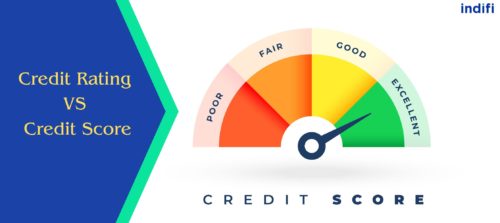
According to the TransUnion CIBIL study, the number of credit-served clients increased from 91 million in 2017 to 179 million in 2021, indicating a jump in credit availability from 12% of adults a few years ago to 22% at that time.
Also, about 40% of Indians regularly monitor their credit scores. Hence, this indicates a growing awareness of the significance of credit well-being. This clearly reflects a positive trend towards better financial literacy and proactive credit management.
Therefore, it has become essential to understand credit scores and credit ratings concerning financial trustworthiness. However, just knowing the meaning isn’t enough, as they are crucial to the financial field.
In this blog post, we will understand the main differences between these two critical financial metrics and their types.
First, it’s important to understand what credit scores and ratings actually mean.
Also Read:- Emergency Finance-Linked Guarantee Scheme (ECLGS) Scheme
What is a Credit Score?
Starting with a credit score, consider it as a three-digit portrait of your borrowed money management skills. These numbers, which credit bureaus provide, represent your creditworthiness, that is, your relative likelihood of paying back what you owe.
Also Read:- Difference Between Consumer Cibil and Commercial Cibil Score
What is Credit Rating?
To simplify your understanding of credit rating, consider it a form of report card for businesses or governments assessing their debt payback capacity. It is an objective assessment of their overall or particular financial reliability.
While credit ratings look at more prominent institutions like businesses and governments, credit scores concentrate on people and reflect their history of handling and paying back personal debt.
Now, let’s elaborate on the understanding of these two by looking at the different types of credit scores and credit ratings.
Types of Credit Scores
India boasts four primary types of credit bureaus, each with a unique credit score computation method. Though they provide somewhat distinct services, each is licensed by the Reserve Bank of India.
| Types of Credit Scores | Details |
| TransUnion CIBIL Score | CIBIL is the oldest and most frequently used bureau. It offers market information, credit histories, and CIBIL scores. CIBIL’s score factors are credit use, credit mix, loan inquiry count, and payment history. |
| Experian Score | It offers credit reports for consumers and data analytics for companies. Experian’s score assesses credit behavior over time, including credit use and timely payments. However, you can go through the differences between CIBIL and Experian to understand these two better. |
| Equifax Score | It provides credit reports, consumer notifications, and various company risk management tools. They strongly consider payment history, credit use, and the number and type of credit accounts. Also DPD will give a clear picture of late payment from the actual date. |
| CRIF High Mark Score | CRIF High Mark Score provides credit reports and commercial services, primarily in India. The score reflects creditworthiness based on credit history, types of credit accounts, payment records, and credit use. |
Types of Credit Ratings
Here are the types of credit ratings classified according to the different categories on the credit ratings scale.
| Category | Description |
| Investment Grade Ratings | It shows a low default risk. Conservative investors find these ratings appealing as they indicate stability and reliability. It includes the following rates:- |
| AAA | It is the best credit quality, indicating a shallow default risk. |
| AA | It has slightly less credit quality than AAA but still has excellent credit quality. |
| A | It has excellent credit quality but with a somewhat higher risk. |
| BBB | It implies good credit quality, though more sensitive to economic fluctuations than higher-rated categories. |
| Non-Investment Grade (Junk) Ratings | It indicates a higher default risk. Generally less preferred by conservative investors but may offer higher returns to compensate for the increased risk. It includes the following rates:- |
| BB | It is a speculative element with a high default risk. |
| B | It implies higher risk with a clear possibility of default. |
| CCC | This implies they are vulnerable and rely on favorable economic conditions to meet debt obligations. |
| CC | This implies that it is highly susceptible to default and very likely to default. |
| C | It is susceptible and either in near default or already in default. |
Also Read:- Alternative Credit Scores to Get Your Loan!
Main Differences Between Credit Scores and Credit Ratings
Here’s a comparison that explains how credit scores and ratings differ.
| Aspect | Credit Score | Credit Rating |
| Purpose | You can use credit scores to obtain loans or credit card approvals and to determine interest rates. | It helps investors and lenders understand the risk of lending to or investing in a company or government. |
| Frequency of Change | It frequently changes based on recent credit behavior, such as paying debt or opening new credit accounts. They can be updated monthly or even more often. | It is reviewed less frequently, usually annually, or when significant financial changes or events affect the entity. |
| Granularity | It provides detailed insights into individual credit behavior and specific factors like recent credit inquiries and account performance. | It offers a broader view of an entity’s financial health, combining various factors into a single rating. |
| Accessibility | Individuals can access their credit scores through credit reports and monitoring services, sometimes at no cost or through subscription services. | It is publicly available through financial news sources and rating agencies’ websites. |
| Influence on Investment | While it affects personal financial stability, it has less direct influence on investment decisions. However, it can impact personal guarantees for business loans. | It directly impacts investment decisions, guiding investors on the risk of bonds and other investment instruments. |
Also Read:- The Impact of Investors on Your Business
Factors Affecting Your Credit Score
Your credit score reveals whether you handle credit properly, acting as a financial report card. Its range is from 300 to 850; the most often occurring FICO score is 8. Still, what precisely affects this score? Let us dissect it here.
- Pay History
Your score’s heavyweight is this one. It reveals how often you have missed payments and whether you pay your bills on schedule. Your score could be better if you paid late or have accounts under collection. A good score depends on regular, prompt payments.
- Amounts Owed
This compares your debt level with your credit limit. High credit use ratios can let lenders know you might have debt problems. To demonstrate your control, ideally, maintain low balances relative to your limits.
- Length of Credit History
Lenders prefer long credit histories since they better reveal your credit behavior. Maintaining old accounts will help you improve this component of your score even if you never use them.
- New Credit
Opening multiple new accounts quickly will temporarily lower your score. Every new application sets off a thorough investigation that could make lenders cautious about your financial soundness.
- Type of Credit in Use
Your score will improve if you mix credit kinds, including loans and credit cards. But concentrate on safely managing your current credit; take your time opening new accounts just for variety. Knowing these elements can help you control and raise your credit score!
Leveraging Credit Growth for Business Success with Indifi Technologies
Your business financial condition will improve if you have solid credit habits and work with appropriate financial professionals like Indifi Technologies. Indifi assists companies in laying a solid economic base, improving creditworthiness and financial stability.
Indifi can assist you in the following ways:
- Indifi’s tools and experience help you more successfully address financial concerns.
- Indifi offers the help required to both reach and surpass your financial goals.
- Good credit habits combined with Indifi’s guidance can result in improved lending terms and arrangements in the future.
Thus, monitoring your credit and collaborating with Indifi Technologies will help your company achieve success.
Wrapping up
Making wise financial decisions depends on an awareness of the variations between credit ratings and scores. Both measures are essential in their respective contexts: credit scores assess personal creditworthiness, while credit ratings, like the Standard and Poor’s ratings, help evaluate company creditworthiness.
However, financial partners like Indifi Technologies enable you to create a solid economic base, enhancing your financial and creditworthiness. Thus, having the appropriate financial partner makes all the difference, whether your goals are sound financial health, financing security, or expansion.
Frequently Asked Questions
- What distinguishes a credit score from a credit rating most fundamentally?
While a credit rating gauges the creditworthiness of companies or government agencies, a credit score examines personal creditworthiness.
- How might a company raise its credit score?
Companies can raise their free credit rating by making timely payments, controlling debt, tracking financial statements, and supporting robust business performance.
- Why should enterprises give credit scores top priority?
Credit scores are essential for controlling personal finances and supporting corporate operations. They affect credit card interest rates, rental agreements, and personal loan approvals.





